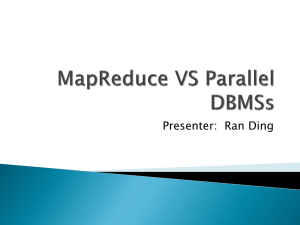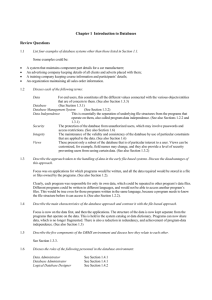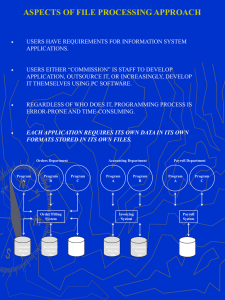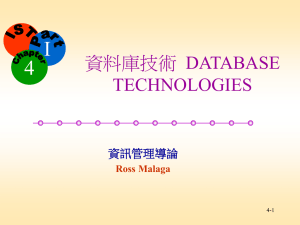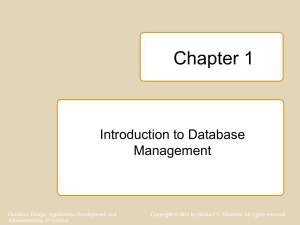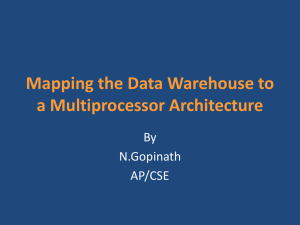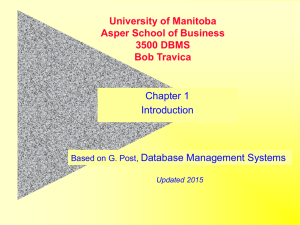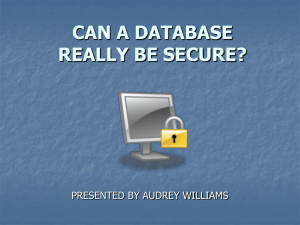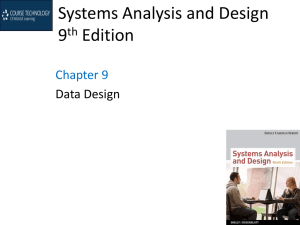of the data.
advertisement
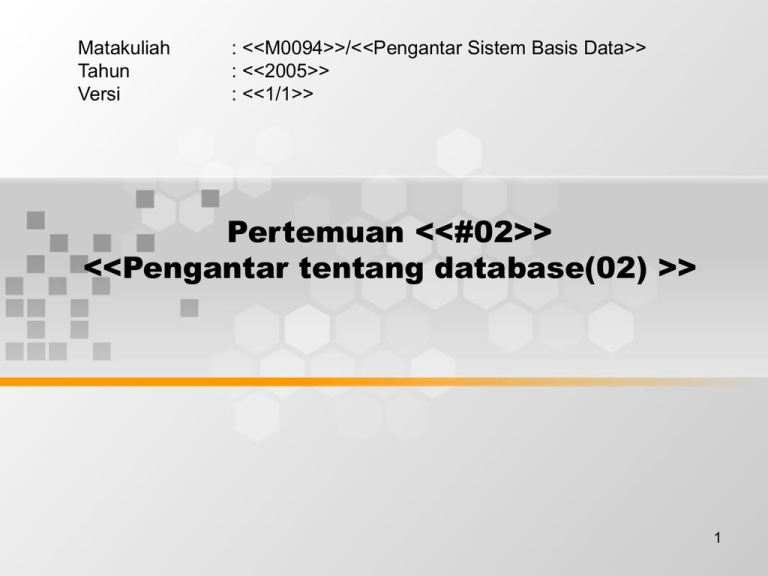
Matakuliah Tahun Versi : <<M0094>>/<<Pengantar Sistem Basis Data>> : <<2005>> : <<1/1>> Pertemuan <<#02>> <<Pengantar tentang database(02) >> 1 Learning Outcomes Pada akhir pertemuan ini, diharapkan mahasiswa akan mampu : • Mahasiswa dapat Menerangkan pengertian tentang DBMS, fungsinya dan komponennya 2 Outline Materi • • • • • definisi database, DBMS fungsi dan komponen DBMS peran/spesialis database perkembangan database kelebihan dan kekurangan database 3 Chapter 1 (lanjutan pert. 01) Introduction to Databases Transparencies 4 Chapter 1 - Objectives Typical functions of a DBMS. Major components of the DBMS environment. Personnel involved in the DBMS environment. History of the development of DBMSs. Advantages and disadvantages of DBMSs. 5 Database Approach Arose because: – Definition of data was embedded in application programs, rather than being stored separately and independently. – No control over access and manipulation of data beyond that imposed by application programs. Result: – the database and Database Management System (DBMS). 6 Database Shared collection of logically related data (and a description of this data), designed to meet the information needs of an organization. System catalog (metadata) provides description of data to enable program–data independence. Logically related data comprises entities, attributes, and relationships of an organization’s information. 7 Database Management System (DBMS) A software system that enables users to define, create, and maintain the database and that provides controlled access to this database. 8 Database Management System (DBMS) 9 Database Approach Data definition language (DDL). – Permits specification of data types, structures and any data constraints. – All specifications are stored in the database. Data manipulation language (DML). – General enquiry facility (query language) of the data. 10 Database Approach Controlled – – – – – access to database may include: A security system. An integrity system. A concurrency control system. A recovery control system. A user-accessible catalog. A view mechanism. – Provides users with only the data they want or need to use. 11 Views Allows each user to have his or her own view of the database. A view is essentially some subset of the database. 12 Views Benefits include: – Reduce complexity; – Provide a level of security; – Provide a mechanism to customize the appearance of the database; – Present a consistent, unchanging picture of the structure of the database, even if the underlying database is changed. 13 Components of DBMS Environment 14 Components of DBMS Environment Hardware – Can range from a PC to a network of computers. Software – DBMS, operating system, network software (if necessary) and also the application programs. Data – Used by the organization and a description of this data called the schema. 15 Components of DBMS Environment Procedures – Instructions and rules that should be applied to the design and use of the database and DBMS. People 16 Roles in the Database Environment Data Administrator (DA) Database Administrator (DBA) Database Designers (Logical and Physical) Application Programmers End Users (naive and sophisticated) 17 History of Database Systems First-generation – Hierarchical and Network Second generation – Relational Third generation – Object Relational – Object-Oriented 18 Advantages of DBMSs Control of data redundancy Data consistency More information from the same amount of data Sharing of data Improved data integrity Improved security Enforcement of standards Economy of scale 19 Advantages of DBMSs Balanced conflicting requirements Improved data accessibility and responsiveness Increased productivity Improved maintenance through data independence Increased concurrency Improved backup and recovery services 20 Disadvantages of DBMSs Complexity Size Cost of DBMS Additional hardware costs Cost of conversion Performance Higher impact of a failure 21 22 << PENUTUP>> Dilanjutkan ke : pert 03 DATABASE ENVIRONMENT 23
